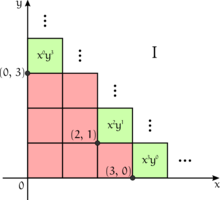Monomial ideal
In abstract algebra, a monomial ideal is an ideal generated by monomials in a multivariate polynomial ring over a field.
A toric ideal is an ideal generated by differences of monomials (provided the ideal is a prime ideal). An affine or projective algebraic variety defined by a toric ideal or a homogeneous toric ideal is an affine or projective toric variety, possibly non-normal.
Definitions and Properties
Let be a field and be the polynomial ring over with n variables .
A monomial in is a product for an n-tuple of nonnegative integers.
The following three conditions are equivalent for an ideal :
- is generated by monomials,
- If , then , provided that is nonzero.
- is torus fixed, i.e, given , then is fixed under the action for all .
We say that is a monomial ideal if it satisfies any of these equivalent conditions.
Given a monomial ideal , is in if and only if every monomial ideal term of is a multiple of one the .[1]
Proof: Suppose and that is in . Then , for some .
For all , we can express each as the sum of monomials, so that can be written as a sum of multiples of the . Hence, will be a sum of multiples of monomial terms for at least one of the .
Conversely, let and let each monomial term in be a multiple of one of the in . Then each monomial term in can be factored from each monomial in . Hence is of the form for some , as a result .
The following illustrates an example of monomial and polynomial ideals.
Let then the polynomial is in I, since each term is a multiple of an element in J, i.e., they can be rewritten as and both in I. However, if , then this polynomial is not in J, since its terms are not multiples of elements in J.
Monomial Ideals and Young Diagrams
A monomial ideal can be interpreted as a Young diagram. Suppose , then can be interpreted in terms of the minimal monomials generators as , where and . The minimal monomial generators of can be seen as the inner corners of the Young diagram. The minimal generators would determine where we would draw the staircase diagram.[2] The monomials not in lie inside the staircase, and these monomials form a vector space basis for the quotient ring .
Consider the following example. Let be a monomial ideal. Then the set of grid points corresponds to the minimal monomial generators in . Then as the figure shows, the pink Young diagram consists of the monomials that are not in . The points in the inner corners of the Young diagram, allow us to identify the minimal monomials in as seen in the green boxes. Hence, .

In general, to any set of grid points, we can associate a Young diagram, so that the monomial ideal is constructed by determining the inner corners that make up the staircase diagram; likewise, given a monomial ideal, we can make up the Young diagram by looking at the and representing them as the inner corners of the Young diagram. The coordinates of the inner corners would represent the powers of the minimal monomials in . Thus, monomial ideals can be described by Young diagrams of partitions.
Moreover, the -action on the set of such that as a vector space over has fixed points corresponding to monomial ideals only, which correspond to partitions of size n, which are identified by Young diagrams with n boxes.
Monomial Ordering and Gröbner Basis
A monomial ordering is a well ordering on the set of monomials such that if are monomials, then .
By the monomial order, we can state the following definitions for a polynomial in .
Definition[1]
- Consider an ideal , and a fixed monomial ordering. The leading term of a nonzero polynomial , denoted by is the monomial term of maximal order in and the leading term of is .
- The ideal of leading terms, denoted by , is the ideal generated by the leading terms of every element in the ideal, that is, .
- A Gröbner basis for an ideal is a finite set of generators for whose leading terms generate the ideal of all the leading terms in , i.e., and .
Note that in general depends of the ordering used; for example, if we choose the lexicographical order on subject to x > y, then , but if we take y > x then .
In addition, monomials are present on Gröbner basis and to define the division algorithm for polynomials with several variables.
Notice that for a monomial ideal , the finite set of generators is a Gröbner basis for . To see this, note that any polynomial can be expressed as for . Then the leading term of is a multiple for some . As a result, is generated by the likewise.
See also
Footnotes
References
- Miller, Ezra; Sturmfels, Bernd (2005), Combinatorial Commutative Algebra, Graduate Texts in Mathematics, 227, New York: Springer-Verlag, ISBN 0-387-22356-8
- Dummit, David S.; Foote, Richard M. (2004), Abstract Algebra (third ed.), New York: John Wiley & Sons, ISBN 978-0-471-43334-7
Further reading
- Cox, David. "Lectures on toric varieties" (PDF). Lecture 3. §4 and §5.
- Sturmfels, Bernd (1996). Gröbner Bases and Convex Polytopes. Providence, RI: American Mathematical Society.
- Taylor, Diana Kahn (1966). Ideals generated by monomials in an R-sequence (PhD thesis). University of Chicago. MR 2611561. ProQuest 302227382.
- Teissier, Bernard (2004). Monomial Ideals, Binomial Ideals, Polynomial Ideals (PDF).